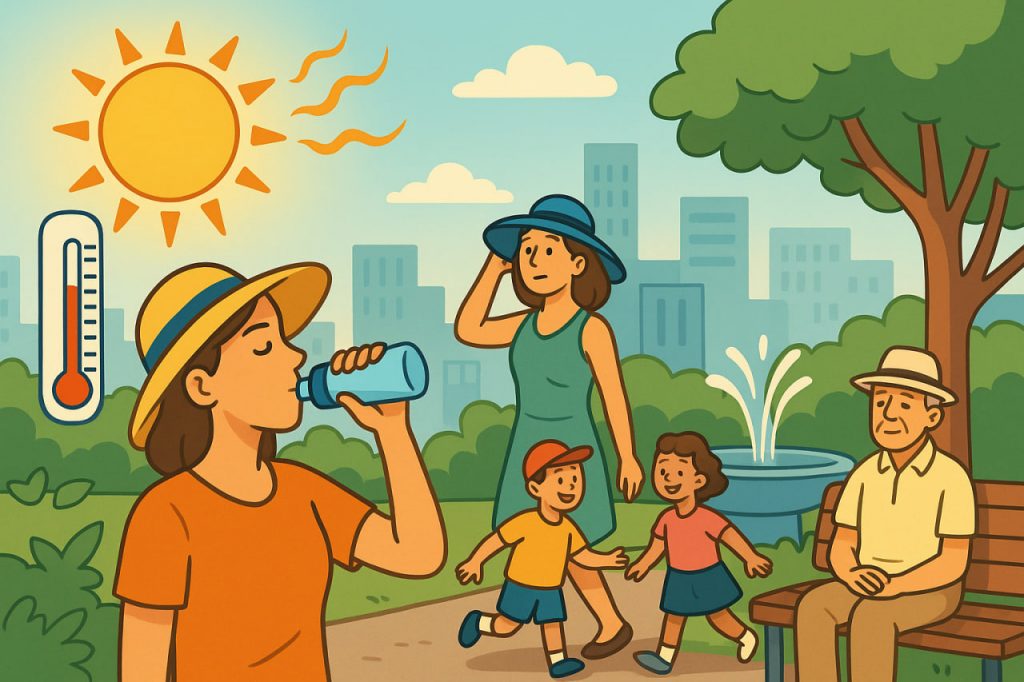When the weather turns extremely hot, the human body faces significant stress. Heatwaves — once rare — are now becoming more frequent due to climate change, and they can pose serious risks to health, especially for children, the elderly, and people with chronic conditions. Understanding how to protect yourself and others from heat-related illnesses is essential for staying safe and healthy during hot weather.
How High Temperatures Affect the Body
The human body maintains an internal temperature around 36.6°C (97.9°F). During extreme heat, this balance becomes difficult to sustain. Excessive exposure to high temperatures can lead to dehydration, heat exhaustion, or even heatstroke, which can be life-threatening.
When the body overheats, sweat production increases to cool the skin. However, if humidity is high or water intake is low, the body cannot release heat efficiently. This can result in fatigue, dizziness, and confusion.
Key Safety Measures to Follow
- Stay Hydrated
- Drink plenty of clean water even if you’re not thirsty.
- Avoid alcohol, caffeine, and sugary drinks, as they cause dehydration.
- Replenish electrolytes with natural drinks like coconut water or diluted fruit juices.
- Avoid Direct Sun Exposure
- Stay indoors or in shaded areas between 11 a.m. and 4 p.m., when the sun is strongest.
- If you must go outside, wear a wide-brimmed hat, light-colored clothing, and UV-protective sunglasses.
- Use sunscreen with at least SPF 30, and reapply every two hours.
- Keep Indoor Spaces Cool
- Close curtains and windows during the hottest hours.
- Use fans or air conditioning to circulate air.
- Place bowls of ice near fans for quick cooling if air conditioning isn’t available.
- Recognize Symptoms of Heat Illness
- Heat exhaustion: heavy sweating, weakness, nausea, dizziness, and rapid pulse.
- Heatstroke: body temperature above 40°C (104°F), confusion, lack of sweating, or unconsciousness — this is a medical emergency.
In case of heatstroke, move the person to a cool area, remove excess clothing, apply cold compresses, and call emergency services immediately.
- Plan Outdoor Activities Wisely
- Exercise early in the morning or late in the evening.
- Take frequent breaks in the shade.
- Always carry a bottle of water and a wet cloth for cooling.
- Take Special Care of Vulnerable Groups
- Children can overheat quickly — never leave them in parked cars, even for a minute.
- Elderly people may not feel heat as strongly, but dehydration can set in rapidly.
- Pets also suffer from heat — provide fresh water and shade, and never walk them on hot pavement.
Nutrition During Hot Weather
- Eat light, hydrating meals such as salads, fruits, and vegetables.
- Avoid heavy, greasy foods that increase body temperature.
- Fruits like watermelon, cucumber, oranges, and berries help maintain fluid balance.
What To Do During a Heatwave Emergency
- Follow local weather alerts and health warnings.
- Visit community cooling centers if available.
- Check on family members and neighbors, especially those living alone.
- Turn off unnecessary electrical devices to prevent overheating and energy overloads.
Long-Term Prevention and Awareness
As global temperatures rise, individuals and communities must adapt:
- Plant more trees and support green spaces in urban areas.
- Improve building insulation and ventilation systems.
- Encourage public education on heat safety and first aid.
Interesting Facts
- The hottest temperature ever recorded on Earth was 56.7°C (134°F) in Death Valley, California.
- Heatwaves kill more people annually than any other natural disaster combined.
- Wearing loose cotton clothing allows sweat to evaporate faster, cooling the body naturally.
- Dehydration by just 2% of body weight can significantly affect mental focus and physical performance.
- Some desert animals, such as camels, survive heat by allowing body temperature to fluctuate throughout the day.
Glossary
- Heatstroke — a severe condition when the body’s temperature rises above 40°C and internal systems begin to fail.
- Electrolytes — essential minerals (sodium, potassium, magnesium) that help regulate fluid balance in the body.
- Dehydration — loss of body fluids faster than they are replaced, leading to fatigue and dizziness.
- UV radiation — invisible rays from the sun that can damage skin and eyes.
- Cooling center — public space equipped with air conditioning for people during heat emergencies.


